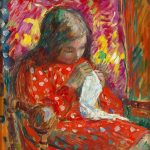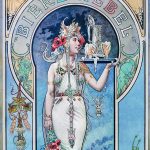Henri de Toulouse-Lautrec (1864–1901) was a French painter, printmaker, draughtsman, and illustrator, whose immersion in the colorful and theatrical life of Paris in the late 19th century allowed him to produce a collection of enticing, elegant, and provocative images of the modern and sometimes decadent life of those times. Toulouse-Lautrec’s short life was marked by illness and physical disability, which led him to develop an early reliance on art as a form of expression.
Born into the aristocracy, Toulouse-Lautrec broke away from the expectations of his family background through his art. His physical condition, which stunted the growth of his legs while allowing his torso to develop normally, confined him to a life that was, from an early age, oriented more towards observation rather than participation. This perspective made him a keen observer of Parisian life, from the cabarets and dance halls of Montmartre to the private spaces of prostitutes and their clients, which he depicted with a candidness that was both compassionate and unjudgmental.
Toulouse-Lautrec’s artistic education included studies at the École des Beaux-Arts in Paris under the academic painter Léon Bonnat. He was heavily influenced by the work of other artists of his time, including Edgar Degas and the Japanese printmakers, whose aesthetics deeply influenced his approach to composition and color. However, it was in the vibrant and bohemian atmosphere of Montmartre, the heart of Paris’s nightlife, that Toulouse-Lautrec found his most enduring subjects. His posters for the Moulin Rouge and other Parisian nightspots are iconic, capturing the lively essence of the era with bold colors, dynamic compositions, and a sense of movement that was groundbreaking.
Toulouse-Lautrec’s contributions to the art world were not limited to painting and illustration. He was also a master lithographer, and his innovations in poster art are considered seminal to the development of modern advertising. Through his posters, Toulouse-Lautrec was able to convey complex narratives and atmospheric depth with a minimal yet striking use of lines and colors. His ability to distill the essence of his subjects into a few deft strokes made his work instantly recognizable and highly sought after, both in his time and in contemporary art circles.
Despite his aristocratic origins, Toulouse-Lautrec was a fixture in the cabarets, circuses, brothels, and bars of Paris, where he found kinship and subjects for his art. His work provides a candid look into the lives of Paris’s lower classes and its bohemian circles, portraying them with dignity and a realism that was devoid of sentimentality or moral judgment. This approach allowed him to capture the humanity of his subjects, making his work deeply empathetic.
Toulouse-Lautrec’s legacy is marked by his ability to capture the spirit of his age with humor, sensitivity, and sharp observation. His body of work is a testament to his innovative approach to art, blending fine art techniques with commercial art practices in a way that was ahead of his time. His depiction of the Parisian demimonde, filled with colorful characters, dancers, singers, and prostitutes, offers a vivid window into the social and cultural life of Paris at the turn of the century.
Henri de Toulouse-Lautrec died at the young age of 36, but his influence on the art world was profound. He was a pioneer in bridging the gap between high art and popular culture, and his work paved the way for modernist movements that would follow. Today, Toulouse-Lautrec is celebrated not only for his artistic innovations and contributions to poster art and illustration but also for his unflinching portrayal of the human condition, making him one of the most beloved and fascinating figures in the history of art.





